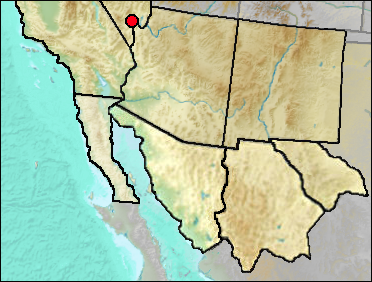 Age. Late Wisconsin. Radiocarbon dates on sloth dung include 10,902 ± 440, 10,075 ± 550 and a sample averaging 8,527 ± 250 (Hester 1960). However, Long et al. (1974:1847) addressed these dates as follows:
Age. Late Wisconsin. Radiocarbon dates on sloth dung include 10,902 ± 440, 10,075 ± 550 and a sample averaging 8,527 ± 250 (Hester 1960). However, Long et al. (1974:1847) addressed these dates as follows:
Our results do not verify the first radiocarbon dates run on sloth dung, dates that have been widely accepted as evidence of postglacial survival. We refer to C-221: 10,455 ± 340 and C-222: 8,527 ± 250, from Gypsum Cave, Nevada. They were analyzed by the now obsolete solid carbon technique of 25 yr ago. Unless they can be replicated, we do not believe they constitute sufficient evidence of the postglacial survival of Nothrotheriops. A-1202 (11,360) is the youngest date from Gypsum Cave that we would accept.
General Description. Cave with several rooms (Harrington 1940).
Fauna.
Amphibia
Anaxyrus punctatus—Red-spotted Toad (Jefferson et al. 2015)
Bufo punctatus
Lithobates pipiens—Leopard Frog (Brattstrom 1954)
Rana pipiens. With the post-Brattstrom changes in the taxonomy of ranid frogs, assignment to species, or even to genus, probably is unwarranted.
Chelonia
Gopherus agassizii—Agassiz's Desert Tortoise (Brattstrom 1954)
Reptilia
Crotaphytus collaris—Eastern Collared Lizard (Brattstrom 1954)
Heloderma suspectum—Gila Monster (Brattstrom 1954)
Sauromalus ater—Chuckwalla (Brattstrom 1954)
Sauromalus obesus
Phrynosoma platyrhinos—Desert Horned Lizard (Brattstrom 1954)
Aspidoscelis sp.—Whiptail Lizards (Brattstrom 1954)
Cnemidophorus tigris
Lampropeltis getula—Common Kingsnake (Brattstrom 1954)
Masticophis flagellum—Coachwhip (Brattstrom 1954)
Pituophis catenifer—Gopher Snake (Brattstrom 1954)
Crotalus atrox (Brattstrom 1954)
Crotalus mitchellii—Speckled Rattlesnake (Brattstrom 1954)
Crotalus oreganus—Western Rattlesnake (Brattstrom 1954)
Crotalus viridis
Aves
Gymnogyps californianus—California Condor (Jefferson et al. 2015)
Mammalia
†Nothrotheriops shastensis—Shasta Ground Sloth (Harrington 1940)
Lepus townsendii—White-tailed Jack Rabbit (Jefferson et al. 2015)
Sylvilagus sp.—Cottontails (Jefferson et al. 2015)
Lynx sp.—Bobcat (Jefferson et al. 2015)
†Canis dirus—Dire Wolf (Jefferson et al. 2015: ? sp.)
Canis lupus—Gray Wolf (Jefferson et al. 2015: ? sp.)
Vulpes vulpes—Red Fox (Jefferson et al. 2015)
Mustela sp.—Weasels (Jefferson et al. 2015)
Spilogale gracilis/putorius—Spotted Skunks (Jefferson et al. 2015)
As S. putorius. The name likely dates from before S. putorius was split into two species.
†Equus conversidens—Mexican Horse (Jefferson et al. 2015)
†Equus occidentalis—Western Horse (Jefferson et al. 2015: cf.)
†Camelops sp.(large)—Large American Camel (Jefferson et al. 2015)
†Hemiauchenia sp.—Extinct Llama (Jefferson et al. 2015)
Odocoileus hemionus—Mule Deer (Jefferson et al. 2015)
Ovis canadensis—Bighorn Sheep (Glowiak and Rowland 2003)
Literature. Brattstrom 1954; Glowiak and Rowland 2003; Harrington 1940; Hester 1960; Jefferson et al. 2015; Long et al. 1974.
Last Update: 1 Apr 2015